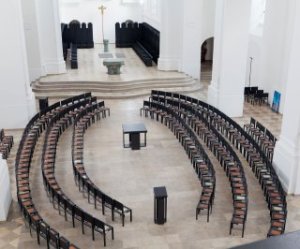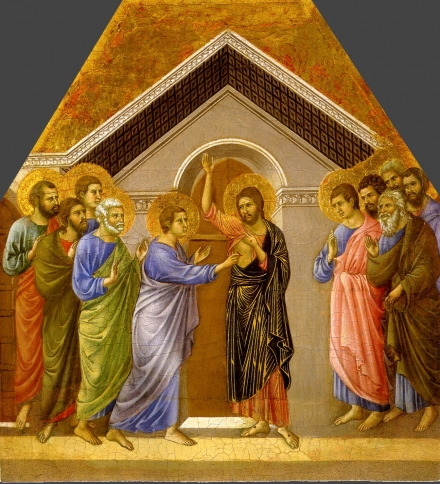"Incredulity of Thomas", Duccio,The Maesta Altarpiece (1308-11 AD)
There are very few apostles, and only a handful of these receive any speaking lines in the Gospels, but St. Thomas the Apostle, today's saint, has two of the best. When Jesus announces that he intends to return to Judea, St. Thomas says to his fellow disciples "Let us also go, that we may die with him" (John 11:16). And after the resurrection, when Jesus appears to St. Thomas, and places Thomas' fingers in his wounds, St. Thomas answers "Thou art my Lord and my God" John 20:28.
Thomas's confession of faith and his brave proclamation of discipleship (even if he didn't quite live up to it at that time) would be legacy enough, but St. Thomas seems to have enjoyed an especially high degree of prestige in the early Church for other reasons. Two very ancient documents
The Acts of St. Thomas, and the
Gospel of Thomas are named for him. Although they are both of gnostic origin, and contain extravagantly fanciful elements (including, for example, dragons), that they are named for Thomas shows he was a widely admired figure, otherwise the gnostics would not have considered St. Thomas' endorsement to be helpful in obtaining acceptance for their heretical views. This same principle is true today, and explains why Tim Howard is more likely to appear on a box of Wheaties than Osama bin Laden. Of course, there is no evidence that St. Thomas did indeed endorse gnosticism, (the
Acts appear to have been written by an astrologer/convert named Bardesanes more than a hundred years after St. Thomas' martyrdom).
Though the
Acts and the
Gospel of Thomas are largely fables, they do contain certain historical details which can be confirmed as factual, or at least probable. For instance, according to the
Acts, St. Thomas preached in India, and was martyred there. Although this can't definitely be established as true, a bishop from India was present at the Council of Nicea in 325 AD, and even today on the Malabar coast of India a community of Christians use a form of Syriac for their liturgical language. In addition, Bardesanes himself was from Edessa, where St. Thomas' relics were venerated, having, according to tradition, been carried there from the East.
St. Thomas the Apostle, who probably preached the Gospel as far away as India, pray for us.














